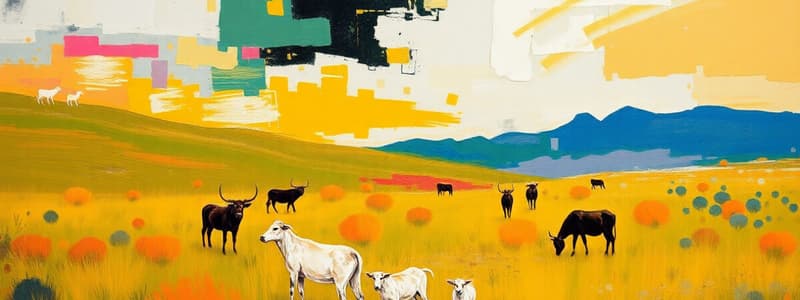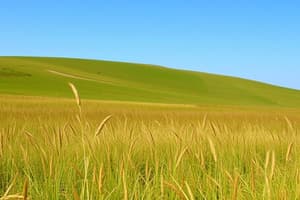Podcast
Questions and Answers
What are the main consequences of melting polar ice caps?
What are the main consequences of melting polar ice caps?
- Reduced oxygen levels in the ocean.
- Increased soil fertility in coastal areas.
- Threatened coastal communities and Arctic species. (correct)
- Enhanced solar energy production.
Which of the following activities contributes the most to greenhouse gas emissions?
Which of the following activities contributes the most to greenhouse gas emissions?
- Cutting down forests. (correct)
- Planting trees.
- Using public transportation.
- Walking or biking.
What is considered a carbon footprint?
What is considered a carbon footprint?
- The total amount of greenhouse gases from human activities. (correct)
- The amount of electricity consumed by a city.
- The weight of carbon used in manufacturing.
- The total amount of water a household uses.
Which type of meal is considered to have the highest carbon footprint?
Which type of meal is considered to have the highest carbon footprint?
Which of the following is a strategy to reduce one's carbon footprint?
Which of the following is a strategy to reduce one's carbon footprint?
What is one consequence of poaching on grassland ecosystems?
What is one consequence of poaching on grassland ecosystems?
How has poaching specifically affected the African elephant population?
How has poaching specifically affected the African elephant population?
What is the main result of overgrazing in grassland areas?
What is the main result of overgrazing in grassland areas?
Which human activity is a significant threat to tundra environments?
Which human activity is a significant threat to tundra environments?
What greenhouse gas is primarily released by human activities that contributes to global warming?
What greenhouse gas is primarily released by human activities that contributes to global warming?
What impact does climate change have on the tundra environments?
What impact does climate change have on the tundra environments?
What is one legislative action taken to combat poaching of elephants?
What is one legislative action taken to combat poaching of elephants?
What is a direct result of industrial development in tundra regions?
What is a direct result of industrial development in tundra regions?
Flashcards
What is a carbon footprint?
What is a carbon footprint?
The total amount of greenhouse gases released into the atmosphere as a result of human activities.
What are greenhouse gases?
What are greenhouse gases?
Greenhouse gases, like carbon dioxide (CO2) and methane (CH4), trap heat in the atmosphere, causing the Earth's temperature to rise.
Why are airplanes carbon-intensive?
Why are airplanes carbon-intensive?
Flying airplanes, especially during takeoff and landing, releases a lot of greenhouse gases because they require significant amounts of energy.
Why are beef and lamb carbon-intensive?
Why are beef and lamb carbon-intensive?
Signup and view all the flashcards
How to reduce your carbon footprint?
How to reduce your carbon footprint?
Signup and view all the flashcards
What is poaching?
What is poaching?
Signup and view all the flashcards
Why are African elephants threatened by poaching?
Why are African elephants threatened by poaching?
Signup and view all the flashcards
What made rhinos a target of poaching?
What made rhinos a target of poaching?
Signup and view all the flashcards
What is overgrazing?
What is overgrazing?
Signup and view all the flashcards
What are the consequences of overgrazing?
What are the consequences of overgrazing?
Signup and view all the flashcards
What are tundras?
What are tundras?
Signup and view all the flashcards
How does industrial development affect the tundra?
How does industrial development affect the tundra?
Signup and view all the flashcards
What is the impact of climate change on the tundra?
What is the impact of climate change on the tundra?
Signup and view all the flashcards
Study Notes
Human Impacts on Grasslands
- Grasslands are home to diverse plants and animals, but human activities negatively affect these ecosystems.
- Human activities harm wildlife, vegetation, and the natural balance.
- Poaching is the illegal hunting for valuable animal parts (e.g., fur, tusks, horns).
- Poaching targets "big-ticket animals" due to high market value.
- African elephants had about 1.3 million individuals in 1979, decreasing to 600,000 by 1988 due to extensive poaching for ivory.
- Poaching has been addressed with international agreements like CITES (Convention on International Trade in Endangered Species) banning ivory trade.
- The African Elephant Conservation Act (1988) further restricted ivory trade.
- Rhino horn has become a high-value commodity, causing a major decline.
- Rhino horn's value surpassed that of gold by 2012.
- Overgrazing (overfeeding by livestock) damages grasslands.
- Excessive grazing leaves land vulnerable, reducing vegetation and causing erosion.
- Overgrazing can transform fertile grassland into desert(desertification).
Human Effects on Tundra Environments
- Tundras are fragile ecosystems in Arctic and high-altitude regions.
- These ecosystems are very vulnerable to human activities and climate change.
- Human activities often lead to environmental damage and ecological disruptions in tundras.
- Industrial development (e.g., pipelines) damages habitats and disrupt wildlife movement.
- Global warming, caused by human actions, leads to higher sea levels and harms Arctic species.
- Greenhouse gases (produced via fossil fuel use, driving, deforestation, and livestock) trap heat in the atmosphere.
- Rising sea levels and melting ice caps (Arctic) threaten coastal communities.
Studying That Suits You
Use AI to generate personalized quizzes and flashcards to suit your learning preferences.




